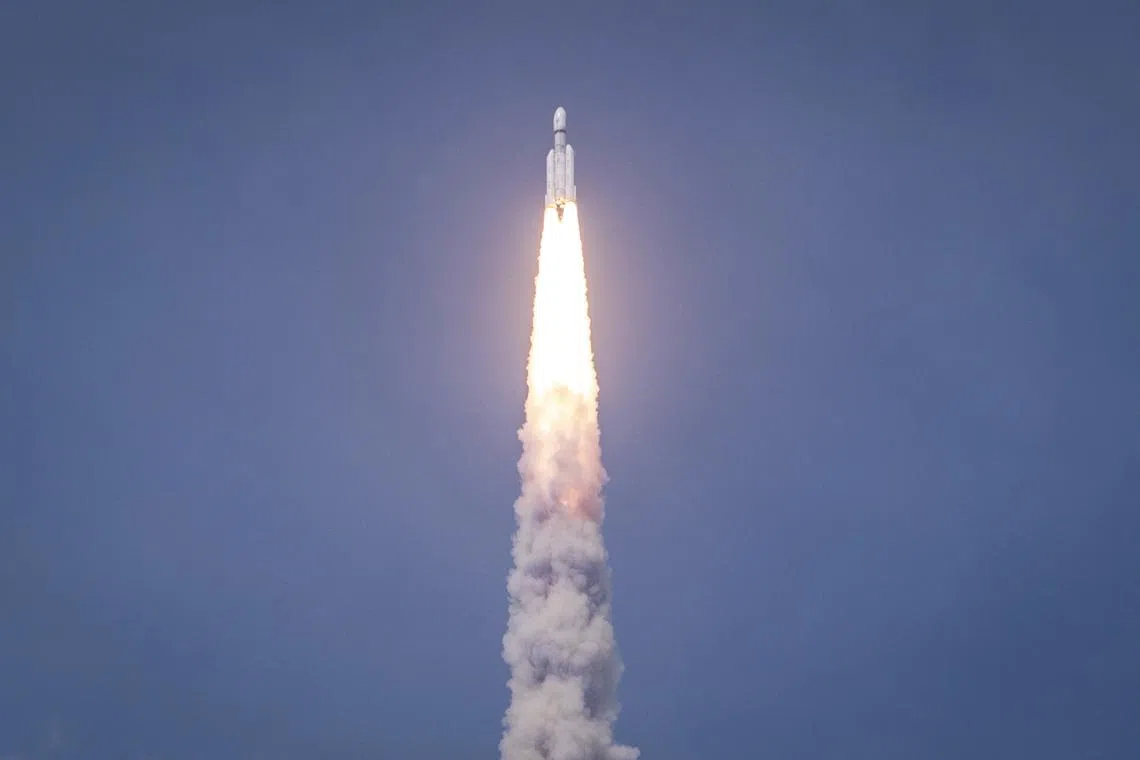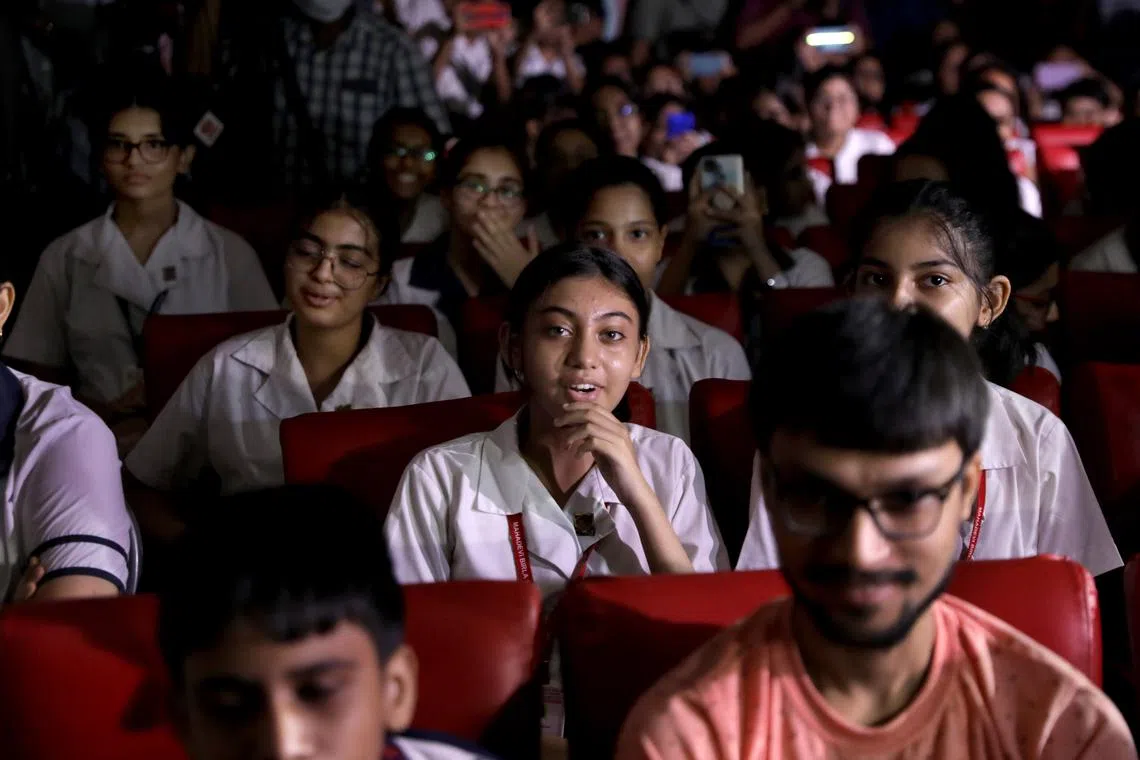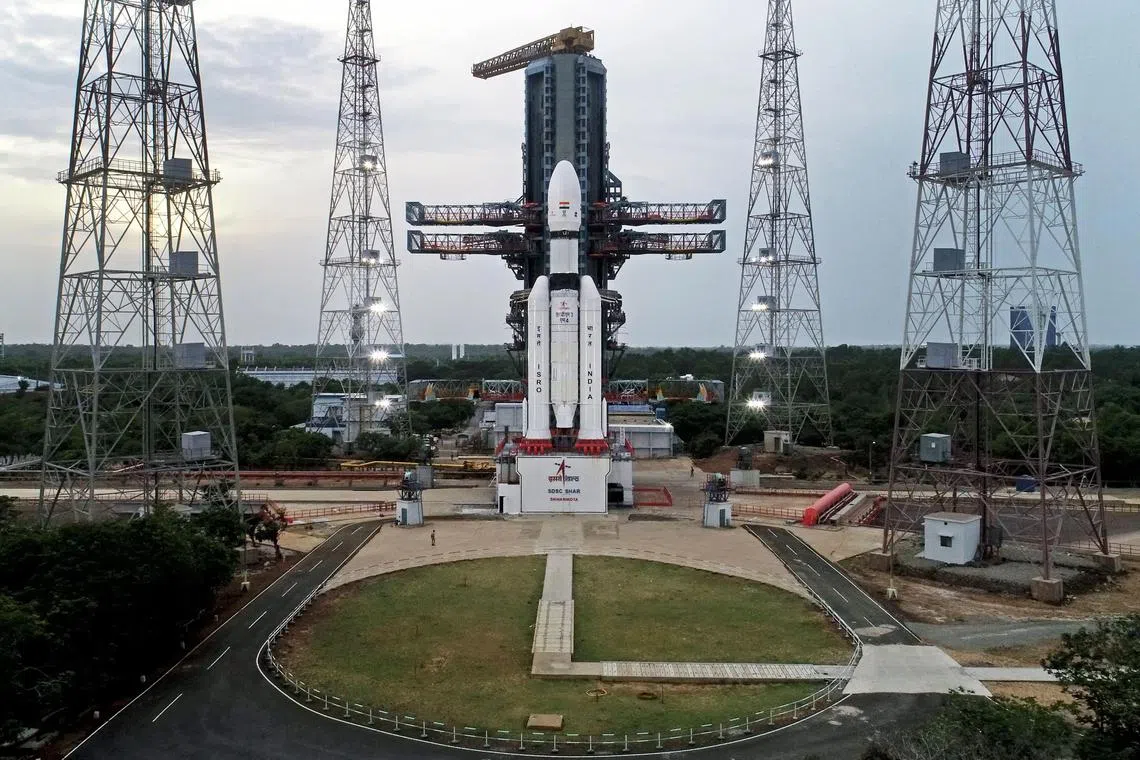India’s historic moon mission takes off smoothly
Sign up now: Get insights on Asia's fast-moving developments

India's Launch Vehicle Mark-III rocket took off at 2.35pm from a space station in Sriharikota, on July 14, 2023.
PHOTO: EPA-EFE
Follow topic:
NEW DELHI – India’s second attempt at making a soft landing on the Moon
Its Launch Vehicle Mark-III (LVM3) rocket took off at 2.35pm (5.05pm, Singapore time) from a space station in Sriharikota off the coast of the southern Indian state of Andhra Pradesh.
The rocket soared through a slightly cloudy sky as anxious officials watched, while enthusiastic schoolchildren and a large number of visitors at the viewing gallery cheered it on.
A lander on board, along with its rover, is expected to attempt a landing on the Moon near its south pole around Aug 23. If all goes according to plan, India will become the fourth country to successfully execute a soft landing on the moon, after Russia, the United States and China.
“Congratulations India... Our dear LVM3 has already put Chandrayaan-3 craft into the precise orbit around Earth,” said Mr S. Somanath, chairman of the Indian Space Research Organisation (Isro), in his address a few minutes after lift-off.
Built on a budget of less than S$99 million, Chandrayaan-3, which means “moon vehicle” in Sanskrit, marks India’s third lunar mission and signals the country’s growing power as a space-faring nation as well as a key player in the global space economy.
India’s last attempt to reach the Moon in 2019 failed as its lander crashed on the lunar surface after engines meant to decelerate the craft developed higher thrust than what was expected.
According to Mr Somanath, the latest lunar mission has been built with a “failure-based design” that factors in several learnings from the earlier mission.
The next 40-odd days involve critical steps, including a successful insertion of the lander-rover duo into a 100km lunar orbit. This will be followed by the duo’s separation from the propulsion module that will ferry them to this orbit, ahead of their tricky and gradual descent towards the Moon.
The lander and rover are carrying scientific instruments to study the Moon’s elemental and chemical composition, its thermal properties, plasma environment and seismicity.
The programmed landing site is situated around 70 degrees south of the Moon’s equator. Most lunar landings have occurred near its equator, leaving the poles largely unexplored.
Landing near the equator is easier, given its smoother and sunlit terrain, unlike the Moon’s polar regions, marked by deep and large craters - many of them several kilometres wide. Many parts here also never receive sunlight, reducing them to permanently dark regions with temperatures that can plummet to minus 246 deg C.
While this creates difficulties in landing and operations, it is these deep, dark and frigid locations that potentially hold secrets to the evolution of the solar system. Much of the new-found water ice is also situated in the shadows of craters in the polar regions.

Indian students react during BITM live telecast of Chandrayaan-3 Mission for students in Kolkata, Eastern India, on July 14, 2023.
PHOTO: EPA-EFE
The reported high volume of water ice on the moon – over 600 billion kg and enough to fill at least 240,000 Olympic-sized swimming pools – has garnered a lot of attention in recent years, with government space agencies and private firms around the world keen to exploit this resource.
In 2009, India’s Chandrayaan-1 mission indicated the presence of ice inside the moon’s polar craters.
Dr Ajey Lele, a consultant at the Manohar Parrikar Institute for Defence Studies and Analyses in New Delhi, said a successful landing and deployment of the rover near the pole may yield further information that could prove critical to future plans of setting up human habitation on the moon.
“Having identified the water molecule is one thing. But can you convert it into usable water? That’s going to be the critical question, not only for India but for the entire world,” he told The Straits Times.
“India is attempting to answer this question and the mission could provide indications about what could be done in the future.”

The Chandrayaan-3 spacecraft would also be the first to land at the lunar South Pole.
PHOTO: EPA-EFE
A successful landing on the Moon will also boost morale at Isro, which is working on other high-profile missions, including Aditya-L1 (a solar mission), Shukrayaan-1 (a Venus mission) and Gaganyaan (India’s first human space flight).
This mission’ success is also expected to provide a boost to India’s nascent private space industry. Godrej Aerospace, a private Indian firm, has provided critical components such as rocket engines and thrusters for this lunar mission.
India’s government has opened up the space sector to private players in its attempt to boost the country’s share of the global space economy – valued at around US$460 billion (S$607.6 billion) – from just 2 per cent currently to 9 per cent in 2030.
In November 2022, Skyroot Aerospace, a Hyderabad-based start-up funded by Singapore’s sovereign fund GIC, successfully launched India’s first privately-built rocket.
Its co-founder and chief operating officer, Mr Bharath Daka, told ST India’s growing space exploration programme, built on the success of Chandrayaan-3, is bound to see greater involvement of private players.
“As the private industry shows its capability in executing space missions, it will be much more involved in future interplanetary missions, not just from a manufacturing point of view – which is already happening anyway – but also from the design and development point of view,” he added.


